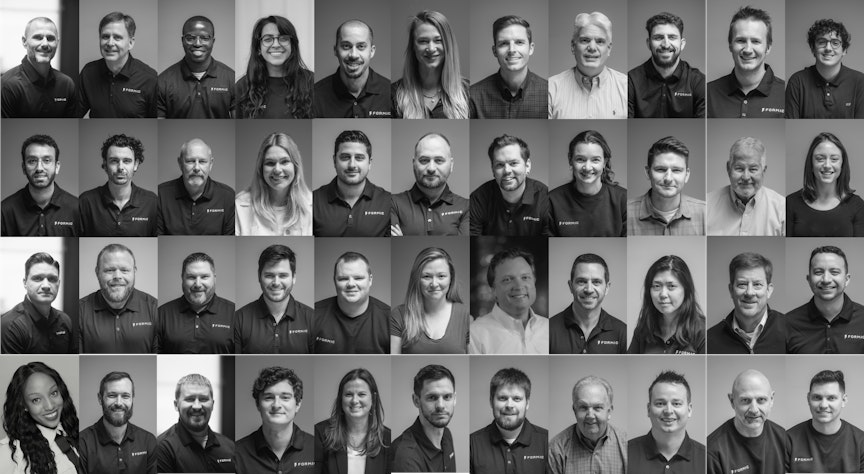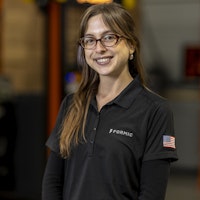While much of the focus in robotics has been on making machines smarter, there's a much bigger challenge hiding in plain sight: getting robots into factories. Robots aren't being deployed at scale because many manufacturers — especially small and medium-sized businesses (SMBs) — face significant barriers to adoption. These challenges include high costs, time-intensive integration, and a lack of in-house expertise to manage automation effectively.
However, as Formic’s Founder and CEO, Saman Farid, pointed out, “If you can make it easy to scope, deploy, manage, and maintain a robot, then you can drive mass adoption.”
Farid recently joined the TBPN podcast to discuss how Formic’s “robot army” is helping SMB manufacturers deploy automation more easily and successfully. While most robots in the U.S. today are deployed by large manufacturers, SMBs make up a majority of factories in the U.S. and supply critical components for large manufacturers. To meet the demands of modern manufacturing, robots need to be deployed more aggressively, especially in SMBs.
That’s where Formic comes in. Our approach offers $0 CapEx, Full Service Automation — meaning no upfront cost for the manufacturer. Instead, we manage everything from scoping and deployment to ongoing maintenance. This helps manufacturers avoid the technical and financial burdens that typically come with automation.
Let’s break down Farid’s conversation on TBPN and how Formic is solving the “last mile” problem of industrial automation, which is the surrounding infrastructure and software required to deploy and manage robots reliably.
The Long Road to Revitalizing U.S. Manufacturing
Farid emphasized that modernizing U.S. manufacturing is a long journey, but it’s crucial for the country’s industrial future. “Industrializing is a 20-year journey at minimum, and probably much longer,” he said. “We have 250,000 factories in America that make all kinds of products. They exist. The problem is we don’t have the labor force to support them.”
Currently, the typical utilization rate of an American factory is less than 2,000 hours out of a possible 8,700 hours a year. In turn, most U.S. factories are sitting idle 75% of the time. This isn’t due to a lack of demand or raw materials, it’s because fewer people want to work in factories, doing repetitive, physically demanding tasks.
“So, until we automate a bunch of them, we’re going to have a really hard time industrializing,” Farid said. “I’m optimistic. I think there is a lot of opportunity to industrialize and bring more manufacturing back, but it's not going to be in a year or two. [Formic is] helping make that happen faster, but it's going to take some time.”
Overcoming the 90% Barrier: Deployment is Key
Getting a robot to do its job is just 10% of the work, while the other 90% is focused on everything that comes after deploying a robot, like error handling, maintenance, programming, and optimization. As Farid put it, "The reason factories in America don’t automate today isn’t because you can’t get a robot to do its job. The problem is the surrounding infrastructure doesn’t exist.”
While a manufacturer might be the best at making deli meat or laundry pods, it doesn’t mean they are equipped to deploy and manage robots on their production line. Without proper support, robot deployment becomes overwhelming — factories don’t know where to start, what to buy, or how to maintain these systems.
Formic solves this problem by providing the necessary infrastructure. We manage the scoping, deployment, management, and maintenance of our automation systems so manufacturers can focus on what they do best. We’ve also gotten fast at it.
“We use computer vision and LIDAR scans to do a full site evaluation in an automated way. This used to take months to walk through the facility and measure every single thing and figure out what you can automate and what robot you need,” Farid said. “We do that in minutes.”
And Formic manages everything that comes after scoping as well: robot simulations to determine the best fit, programming the robot, managing the robot after it's deployed, and ongoing preventative and corrective maintenance.
“Most roboticists are working on the wrong problem,” Farid said. “From the hundreds of robots we’ve deployed today, less than 5% of my deployment cost is programming the robot to do the thing it needs to do. I need to focus on solving the other 95% of the cost of deploying robots.”
No CapEx, More Impact: Transforming CPG Factories
In industries like consumer packaged goods (CPG), automation can have a significant impact. In the U.S., a typical CPG facility runs between 20 to 24 hours a day, making them perfect candidates for automation. That’s why Formic works with so many CPG companies — we’ve seen the automation needs and immediate impact.
Additionally, most CPG production is happening domestically, and the factories have end-of-line tasks that are “the most backbreaking, painful jobs,” Farid said. Many of our customers have turned to automation to improve employee well-being and productivity. Now, our robots pack and stack boxes while employees do more revenue-focused work.
What sets Formic apart is that these SMB manufacturers can automate without incurring any CapEx. While large companies like General Motors and Procter & Gamble have the in-house expertise to manage robots, the vast majority of U.S. factories — especially SMBs — lack the resources and technical know-how. Farid explains, "For every General Motors plant, there are 4,000 smaller factories that provide components, and 95% of them don’t have robots."
Initial equipment cost is a significant barrier to automation, but as Farid explained, only 30% of the cost is the hardware itself (the robot arm and conveyors), and 70% is consumed by custom engineering, which requires hiring integrators and consultants. Small factories don’t have the in-house engineering expertise to deploy robots successfully. Formic's model eliminates the need for this custom engineering, making automation affordable and accessible for SMBs.
Building the Future of American Manufacturing
Despite the rapid advancements in robotics, only 30,000 of the 400,000 robots deployed globally last year were in the U.S. The primary challenge American manufacturers are still facing is fewer engineers and a lack of infrastructure.
“In the U.S., we have this challenge where there are a lot more small, medium-sized businesses, and we don’t have the historical infrastructure or engineering capability for all of these plants to figure out how to automate on their own,” Farid said.
That’s why Formic is building the tooling and “walking the walk” of making automation accessible. The next step? Cultural change.
“The incentive is there. There are financial incentives for factories to [automate],” Farid said. “Many factory owners are third-generation businesses. They’ve been passed down, or they are private-equity owned. In both cases, you end up with very risk-averse businesses.”
Cultural change will be key, and Formic is leading the charge. We’re trained end-of-line employees to operate our robot systems during every deployment. Last week, we hosted our second in-person Automation Community event with a behind-the-scenes tour to see robots in action. And next month, we’re hosting a webinar with SNAXPO on how to get started with automation and common first-time mistakes.
The future of manufacturing is automation, and the time to act is now. Whether you're a small factory owner or a manufacturer looking to scale, Formic's proven model can help you navigate the complexities of robot deployment. Join us in reshaping the future of American manufacturing — because automation is not just the future; it’s the now.
Watch the full TBPN interview here.


